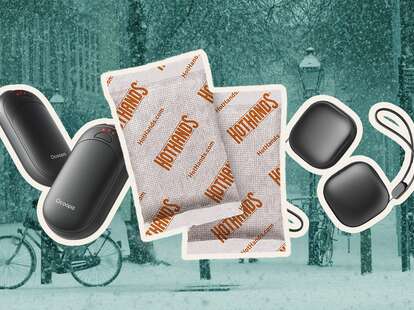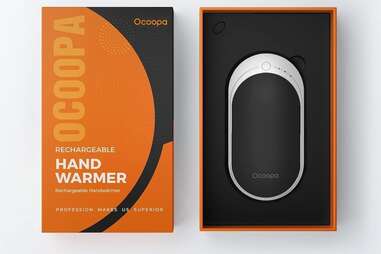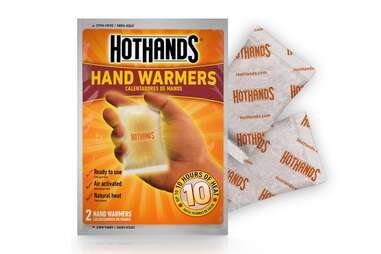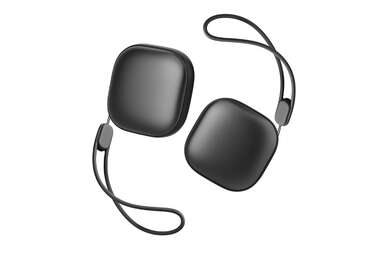The Best Editor-Approved Hand Warmers for All Types of Winter Travel
The, er, hottest picks to make winter storms, snowy ski slopes, and freezing temperatures manageable

I was crying at the base of a Mammoth Mountain ski run in California when I first encountered hand warmers. A tween from Los Angeles, I was drastically out of my comfort zone standing knee-deep in powder snow, numbness creeping up my fingertips. After a few minutes of whining, my mother placed a warm, felt sack radiating heat into my small palm, shutting me up like a pacifier. I didn’t know what I was more shocked by, that she was gatekeeping hand warmers from me, or the fact that this foreign object resembling a silica packet could cure my frostbite (and attitude).
Years later, as an adult living in New York City, I discovered the hand warmer industry had leveled up. Most hand warmers on the market now are electric, compact, and sleek enough to resemble an iPhone or an Elf Bar. With such a wide range of upgraded and classic hand warmers, keeping your digits warm has become easier and more sustainable, which is its own kind of comfort.
So what makes the perfect hand warmer? After testing numerous products and scouring online reviews, I found that warmth, longevity, cost-efficiency, and overall convenience to be the top priorities. While there are some powerful models, like Zippo’s refillable hand warmer, which is beloved by park rangers, I knew I realistically wouldn’t want to spend more money on fuel refills than on the device itself. Next! And I found that the eco-friendly reusable, manual hand warmers don't last nearly as long as some others.
But there are some new handwarmers that manage to turn up the heat longterm without crushing your wallet. We put the fancy new iterations and their original analog counterparts to the test. Read on to find the best hand warmer to clutch this winter.

After seeing the Ocoopa top every hand warmer listicle on the internet, I was both intrigued and skeptical. This country can’t agree on anything, let alone which hand warmer is best. It wasn’t until I received the glowing recommendation of my outdoorsiest “correspondent,” a longtime family friend and marathon runner with Raynaud’s disease — a condition in which one’s fingers, ears, and toes go numb in response to cold weather or stress — that I believed the hype. I’m still in shock over how hot such a small device could get (131 degrees Fahrenheit, to be exact). Whether I’m lying under my duvet in my already well-heated bedroom or out grabbing coffee on a frigid morning, I alternate between gripping the device in my hands or pressing it to my cheek.
If I had one bone to pick, it would be the Ocoopa’s size. It takes a bit of effort to fully outstretch my hands so I can cradle my fingers around it. Plus, the device doesn’t offer many attention-grabbing reminders to plug it in, so you actually have to remember to plug it in yourself. So goes the age-old issue with rechargeable products. This minor inconvenience can become a major feat for forgetful people such as myself. That being said, it hardly takes two hours of idle charging to get to a full battery. From there, the Ocoopa lasts for four hours on the highest setting (which you’ll only need if you’re trekking through the Arctic or microdosing the Yellowjackets experience), and eight hours on the lowest (95 degrees Farenheit).

There’s a reason why Hothands have been around for so long and maintain their status as a classic: They’re inexpensive, reliable, and compact. Years after my first slope-side introduction to the brand (and my mother’s hand warmer-driven redemption arc), I still depend on these disposable staples. Before leaving my apartment, I make sure to stuff sleeves of HotHands into my bag, in case of emergency. These packets are small but mighty, and they exude almost as much warmth as many rechargeable hand warmers do on their highest setting. Most surprisingly, HotHands lasted much longer than I initially gave them credit for — I left a packet in my jacket pocket for nearly six hours and was overjoyed to discover it was still radiating heat at full force without damaging my jacket or burning my skin. Even after the majority of a workday, the HotHands made my walk home in 20-degree weather much more bearable than my usual shiver-strutting.
The actual science behind Hothands befuddles me, but there’s no reason to reinterrogate a tried-and-true favorite. The only downside to these is that they are single-use, which can be a mixed blessing. They’re great for anyone prone to losing things, outdoor enthusiasts without guaranteed electricity, and anyone traveling with temperature-sensitive medical conditions or disabilities. If you’re looking for a more environmentally friendly option, or just don’t want to have to keep repurchasing them, they may not be your everyday option.

Mark my words: This hand warmer is going to be a sleeper hit. Although hand warmers across the industry have significantly improved over the years, their bulk has grown too. It took me a week of fine-tooth-combing the internet to find a standout rechargeable choice that could fit comfortably into the palm of my hand, which, as a five foot tall woman, is smaller than the average adult’s. The Okayice Pocket Size Hand Warmer is not only a nice size but super lightweight; I can slip it in my pockets and not feel bulky or hold it while on a run without having to put effort into clenching it. However, this hand warmer’s greatest innovation might be its wrist loop. That strap also makes these warmers an ideal alternative for people whose body temperature fluctuates or prefer having the option to free their hands to avoid palm sweat. Thanks to the strap, I haven’t lost track of this hand warmer once. That’s the highest praise I, a frazzled person who misplaces their phone approximately five times a day, can give.
Unfortunately, this hand warmer definitely doesn’t get as hot as the other selections. But because they come in a set of two, clocking in at about $13.50 each and $27 total, it’s the perfect budget-friendly option.